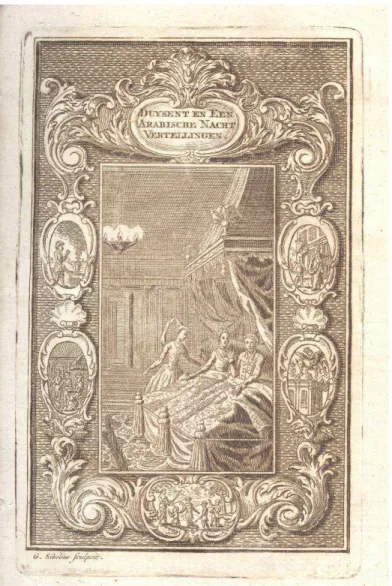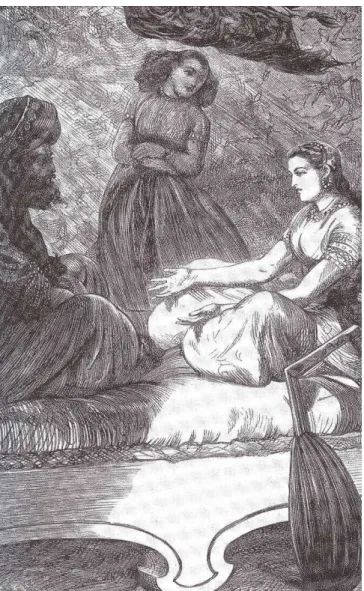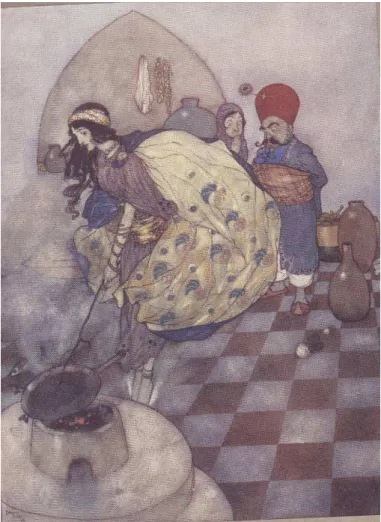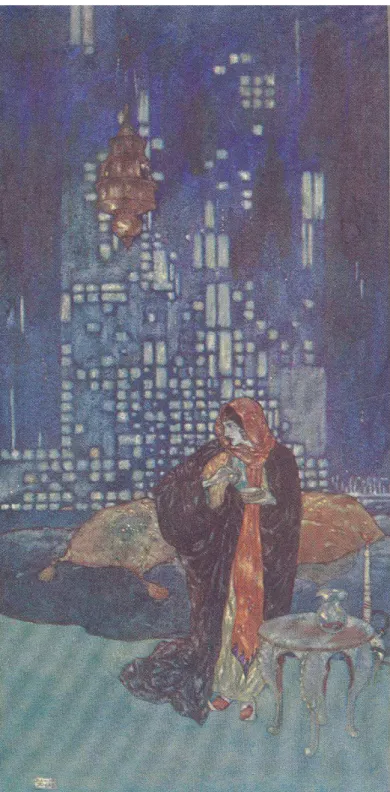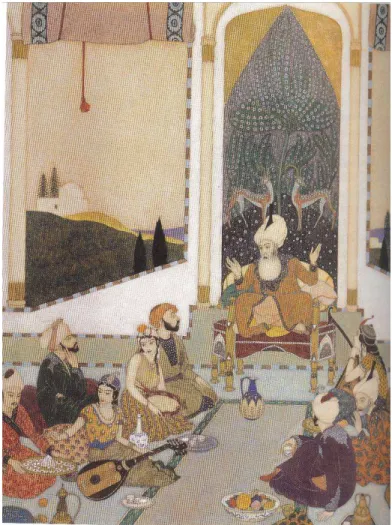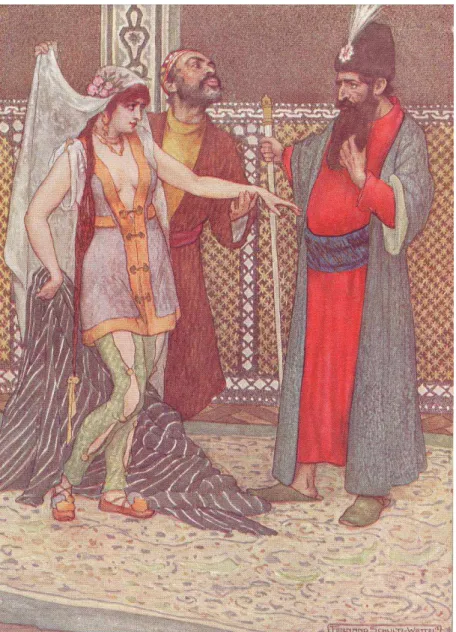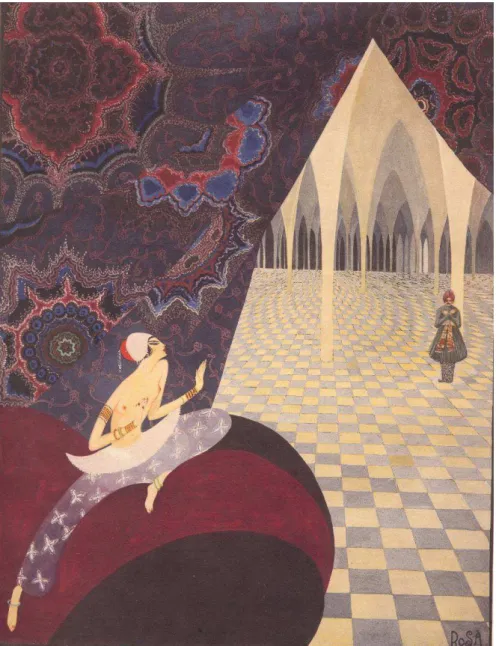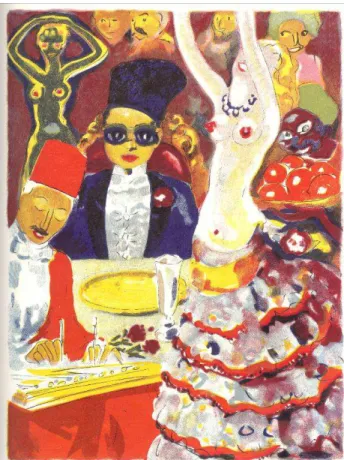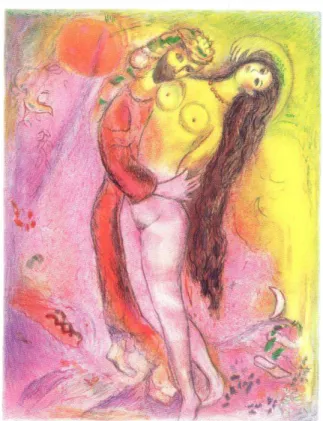Richard van Leeuwen
THE ICONOGRAPHY OF THE THOUSAND AND ONE NIGHTS
AND MODERNISM:
From Text to Image
Whereas in the eighteenth century and the first half of the nineteenth century the Thousand and one Nights contributed relatively little to the European iconography of Orientalism, at the end of the nineteenth century the number of illustrated transla-tions, anthologies and reworkings increased, due to improved printing techniques and the gradual amalgamation of Orientalist and modernist trends in art. A new imagery was developed that not only incorporated visions of the Orient, but Oriental aesthetics as well, thus integrating Oriental styles into modernist art. This development is illus-trated by the example of Edmund Dulac, one of the most prominent illustrators of the Nights. Moreover, the convergence of these trends resulted in a more autonomous function of the imagery of the Thousand and one Nights: it was no longer subservient to the narrative, but rather came to dominate the perception of the stories.
RELIEF 4 (2), 2010 – ISSN: 1873-5045. P213-236 http://www.revue-relief.org
URN:NBN:NL:UI:10-1-101250
Igitur, Utrecht Publishing & Archiving Services © The author keeps the copyright of this article
During the twentieth century a rich and influential iconography devel-oped around what may be called the ‘phenomenon’ of the Thousand and
one Nights. The term ‘phenomenon’ indicates that this iconography gradually transcended the confines of the various texts of the Thousand
and one Nights, either the original Arabic versions of the tales or the many European translations. Within our modern and postmodern outlook im-ages referring to the tales of Shahrazâd have not only become a familiar part of visual culture; they also have to a large extent determined our vi-sion of the ‘real’ Orient. Thus, it seems that the imagery of the Thousand
and one Nights has detached itself from its textual origins, that it is no longer imprisoned in its narrative function and that it has become part of a broader, more universal layer in the tradition of visual culture, with a complex fabric of connotations and references that is only partly shaped
by the textual framework. This change not only reflects the enormous expansion of the influence of visual culture during the course of the twentieth century, but also the changing reception of the Thousand and
one Nights in modern culture.
In this paper an effort will be undertaken to analyze the transfor-mation of the relationship between the iconography and texts of the
Thousand and one Nights. This transformation, it is argued, occurred espe-cially in the modernist period, when European societies reappraised their cultural and scientific foundations as the embodiment of modernity. The focus will be on the period between 1900 and 1950, which not only wit-nessed a profound transformation of European visions of itself and the world, but which also produced an enormous amount of illustrated edi-tions of the Thousand and one Nights, mostly in the form of anthologies and reworkings. But before discussing some examples of illustrations from this period, focusing on the work of Edmund Dulac, we will first take a look at the preceding tradition of Thousand and one Nights illustra-tions.
The formation of a Western tradition of the Thousand and one Nights
It is only in recent years that researchers have started to focus on the ico-nography of the Thousand and one Nights as a separate subject, especially with regard to Western translations. The first European translation was the Mille et une nuits by Antoine Galland, which appeared in Paris in twelve volumes from 1704-1717. This edition – a compilation of trans-lated stories from an authentic text supplemented by tales of various ori-gins – was soon translated into the main European languages and thereby not only introduced the Thousand and one Nights to a new and vast audience, but also laid the foundation of what would become the European ‘tradition’ of the Thousand and one Nights. The tales quite rap-idly struck roots in European literature and culture, through a series of characteristic translations, especially into French, German and English, through many reworkings of the collection or of individual tales, and through the influence of the form, themes and atmosphere of the tales on European authors of various ilk.1
It would be beyond the scope of this article to present an overview of editions of the Thousand and one Nights in European languages and lit-erary works inspired by Shahrazâd’s tales both in form and content. Suf-fice to say that especially in the course of the nineteenth century a tradi-tion of translatradi-tions developed that continued the first efforts by Galland
and that each reflected the mentalities of the period and, to be sure, of the translator, and, more specifically, the forms of Orientalism associated with them. Each translation, the English one by Lane (1838-1840) and the German ones by Habicht (1825) and Weil (1838-1841), claimed to repre-sent the authentic Thousand and one Nights, as derived from newly dis-covered manuscripts. Whereas Lane’s translation reflected the narrow-mindedness and prudery of the Victorian bourgeoisie, the translation by Richard Burton (1885-1888) represented the other side of Victorian atti-tudes, with its fixation on sexuality and its struggle with the incorpora-tion of ethnic diversity within a colonial framework.
Through these translations, which were not based on sound phi-lological foundations, the Thousand and one Nights, as a rather amorphous collection of stories, gradually became rooted in European literature and culture. Important literary works from the eighteenth and nineteenth centuries refer to it either explicitly or indirectly, and it became an inspi-rational text for formal and thematic experimentation and renewal, so that the Nights were incorporated into the European cultural field in a variety of ways. Apart from the many re-editions of the translation by Galland, which appeared in many languages during the nineteenth and twentieth centuries, some editions more than others influenced visions of the Thousand and one Nights at the end of the nineteenth century. First, the large anthology published by the brothers Dalziel in 1863-5 marked an important stage in popularizing the tales, in an edition that was lavishly illustrated. Second, Richard Burton’s translation reflected many of the typical preoccupations of the Victorian age, but it also attempted to break away from the prejudices and constraints of the period. Burton’s ideas on sexuality, for instance, prefigured the trends of sexual liberation in the 1920s and his sometimes rather eccentric idiom and vocabulary heralded later stylistic experiments by modernist authors. A German translation of Burton’s version, supplemented with erotic illustrations, appeared in 1907-8.
The translation that was most influential in the modernist period, however, was the one published between 1899 and 1904 by J.C. Mardrus, an Egyptian of Caucasian descent, who was a regular visitor of Parisian literary salons. According to Mardrus himself this translation was based on an Egyptian manuscript that he possessed, although he also stated that it contained stories that he had heard from his Caucasian grand-mother. Later examinations showed that Mardrus had simply rewritten existing translations of the tales and had taken stories from anthologies
of Indian tales. He had himself rephrased the translations and added passages to enhance the Oriental, and especially erotic, associations in the work. Mardrus’ ‘translation’ was fiercely criticized by Orientalists, who accused him of falsifications and philological deceit, but it was hailed by literati, who said, rather paradoxically, that Mardus’ tampering with the text enhanced its authenticity. The work was re-translated into English in 1928-30 by Powys Mathers, and subsequently into other Euro-pean languages, and became one of the standard versions throughout the twentieth century.2
The main translations of the Thousand and one Nights were supple-mented from the middle of the nineteenth century by an ever increasing number of partial editions, children’s editions and reworkings, which found their way to a wide and varied audience and which impregnated the European imagination with the stories.
It is often assumed that the proliferation of European translations of the Thousand and one Nights and the forms of literary Orientalism that it entailed were conducive to the formation of a large reservoir of images and representations dominated by specific characters, such as Shahrazâd and Shahriyâr, Aladdin, Sindbad, and by settings such as harems, Orien-tal palaces, deserts etc.3 These images were part of a complex interrela-tionship between narratives and reality: they not only characterized the
Thousand and one Nights as a collection of tales, with their atmosphere of exoticism, fantasy, and magic, they also shaped and were shaped by vi-sions of the Orient as they had evolved in Europe as part of complicated cultural, religious, and political encounters. Since most translators claimed that ‘their’ version of the Nights presented a faithful image of the ‘real’ Orient and the ‘real’ Oriental, the collection gradually became not only the quintessential example of Oriental literature, but also the quin-tessential representation of the Orient.
This convergence of the imagery evoked by the stories of Shah-razâd and discourses of the Oriental ‘other’ that developed during the era of European colonial expansion would suggest that the Thousand and
one Nights became the main source of what is generally called Oriental-ism, both in its cultural and ideological manifestations.4 Still, the relation-ship between the Thousand and one Nights and European Orientalism is more complex. This becomes evident especially in the field of the illustra-tions and iconography of the work. Considering the exotic and fanciful nature of the tales, one would expect that a rich and colourful iconogra-phy would have accompanied the swift popularity of the Nights after
Galland’s translation. Contrary to expectations, however, the tradition of the Thousand and one Nights illustrations developed slowly, and only at the end of the eighteenth century did it become a regular habit in France and England to add illustrations to the various editions. The early edi-tions, for example the one from 1706, contained no illustrations added to the individual stories spread throughout the book, but as a rule only a frontispiece with an engraving, framed by vignettes or small references to scenes from separate stories.
It is remarkable that the engravings in the early editions show few orientalizing effects. They usually present an image of Shahriyâr in bed, with Shahrazâd lying beside him or standing next to the bed, sometimes engaged in the act of storytelling (Peyraube, 100; Kobayashi, 171-3). The design of the bedroom is distinctly European, with a canopy, architecture in Classicist style, and medieval rather than Oriental clothes, Shahrazâd wearing a tall pointed hat, with a veil hanging from it, for example. The only references to the Orient are Shahriyâr’s small turban, and the cos-tumes of some of the figures pictured in the vignettes in the frame (fig. 1). It would seem that the illustrator would rather draw attention to the an-cient character of the stories, which was also a form of exoticism, rather than to their Oriental origin. This trend can also be perceived in the more numerous illustrations of the late eighteenth century and the beginning of the nineteenth century, which use small details in clothing and objects (a dome, a palm tree, a scimitar) to refer to the Orient, but which are oth-erwise devoid of orientalizing effects.
It would seem, therefore, that the contribution of the early editions of the Thousand and one Nights to Orientalism, at least with regard to the visual arts, was limited. What is usually considered to be the high tide of European Orientalism occurred in the middle of the nineteenth century, when a distinct Orientalist trend evolved in European painting, con-nected with the emerging wave of Romanticism. Within the school a very rich Oriental iconography was developed that came to contain persistent stereotypical images of the Orient, such as scenes in harems, bathhouses, coffeehouses and palaces, slave markets, desert landscapes, figures such as turbaned dignitaries, soldiers in uniform, Bedouin and black slaves, and themes related to sensuality and violence. In most cases the scenes and themes would picture the Orient as the antithesis of Western socie-ties, with their beginning industrialization, urban growth and advancing modernity.5
Fig. 1. Frontispice of a Dutch edition of Galland’s Mille et une nuits: De Duysend en Eene
Nacht, Arabische Vertellingen, vol. 1, Amsterdam, Steven van Esveldt, app. 1750; the engraver was G. Sibelius.
In Orientalist paintings of this period references to the exotic world of the Middle East are abundant and detailed. Not only is the setting immedi-ately recognizable as Oriental, it is filled with all kinds of orientalizing effects. Interiors are lavishly decorated with woodwork, tiles, pillars and Oriental ornaments; they are filled with a variety of typically Oriental objects such as divans, small wooden tables with inlaid ivory, narguilehs, fountains, metal vessels and lamps, teapots, etc. Furthermore, as in Euro-pean paintings in the Renaissance, the Orient is present in a large variety of textiles and fabrics, in the form of curtains, pillows and carpets, but also, prominently, in the garments of the figures, which wear richly deco-rated silks, typical headdresses, uniforms, veils and long coats and dresses. It is clear that the painters intended to show their virtuosity by picturing every minute detail and thus convey the subtlety and finesse of
Eastern handicrafts. The result consists of realist or even hyper-realist images, which convey a stunning, exuberant and imposing vision of an exotic world.
It is remarkable that, although the Thousand and one Nights had struck root throughout Europe, the wave of Oriental painting that came to be considered as the quintessential form of modern romantic Oriental-ism, never refers to Shahrazâd and her tales. There are no representations of narrative scenes taken from the Nights or of well-known characters such as Sindbâd or Aladdin. Although of course themes and settings may have been derived from descriptions in the Thousand and one Nights, there is no evidence that this was the case, and it seems more likely that paint-ers drew their inspiration from travelling and an increased familiarity with Oriental objects and their aesthetics. The paintings show an over-whelming visual experience, which may be based on existing preconcep-tions of the East as an exotic realm, but which did not explicitly refer to the textual reservoir of representations. There is no obvious link between visual images and their narrative counterparts.
There was, apparently, a clear demarcation between Orientalist art on the one hand, and the iconography of the Thousand and one Nights on the other. Whereas the illustrations of the Thousand and one Nights reveal little inclination towards prominent exoticizing effects, the mainstream of Orientalist painting was not affected by the popularity of the Thousand
and one Nights. This may of course be caused by the fact that book illus-tration and painting were two distinct traditions, each governed by their own conventions. Still, both were based on a form of realism, the illustra-tions by restricting Oriental elements, the paintings by an almost photo-graphic rendering of details. Apparently, the strangeness of the Orient – and of the Oriental stories – could only be conveyed in a convincing way by accentuating its embededness in material reality. After all, the paint-ings as well as the stories claimed to represent the authentic Orient, and only by the semblance of fidelity could the tension between this truthful-ness and fantasy be preserved. Moreover, the realism of the illustrations of the Thousand and one Nights enhanced their narrative character, as in-terdependent evocations of specific scenes, enhancing their dramatic ef-fect.
The separation between trends in art and the iconography of the
Thousand and one Nights began to become blurred in the famous English translation of Edward Lane, which appeared in 1838-40. The translation was characterized by a scrupulous attention to anthropological detail and
for its explicit censoring of ‘obscene’, distasteful or bizarre passages and stories. The engravings made by William Harvey show a similar taste for what may be called Orientalist realism, changing the scenes from neo-classicist or culturally neutral settings to the clearly Eastern settings of Oriental paintings. Harvey showed an evident interest in decorative de-tails and a faithful rendering of material culture, locating the narrative scenes firmly in a realist setting, with only occasional effects to heighten dramatic tension. This form of Orientalist realism would remain popular in editions of the Thousand and one Nights throughout the second half of the nineteenth century, probably in response to the basic realism of the stories themselves and claims of their representational veracity (Kobaya-shi, 175-6).
Apart from this ‘classic’ Oriental style, towards the end of the nine-teenth century illustrations of the Thousand and one Nights became in-creasingly influenced by ‘modern’ trends in art. In the popular anthology edited by the Dalziel brothers, which was published in 1864-5, illustra-tions were incorporated by well-known Pre-Raphaelite artists, such as Dalziel himself, Millais, Watson and Houghton. The latter, for instance, combined the narrative function of his representation, marked by Orien-tal details, with hints at a figurative meaning, or, as it has been called, a ‘disguised symbolism’ (Life). Moreover, the beginnings of the linear style of Art Nouveau can be perceived (fig. 2). A similar transition can be per-ceived in the illustrations added to Richard Burton’s translation of the
Nights, which appeared in 1885-8. Here, the paintings by Alfred Letch-ford show a basic realism, with rather limited Oriental effects, which is sometimes invaded by visionary elements, which call to mind the sym-bolist interest in supernatural forces underlying reality. Apart from this, the few illustrations contributed by Lalauze reveal the outlines of the vi-sions of Art Nouveau (Kobayashi, 177-180). Gradually, the imagery of the
Thousand and one Nights was incorporated into the modern trends in European art.
Fig. 2. Illustration by Arthur Boyd Houghton, ‘Schehera-zade Relating the Stories to the Sultan,’ Frontispice for The Arabian Nights’ Entertainments, (1865), from: David Latham (ed.), Haunted Texts; Studies in Pre-Raphaelitism,Toronto etc., University of
To-ronto Press, 2003, fig. 8.1. Modernism and the Thousand and one Nights
The concept of modernism, with its periodization and its characteristics, is still, or again, a subject of debate. What is clear is that it refers to a pe-riod in which established visions of the world and established traditions in culture were questioned and changed. Experiments in the arts cast a new light on the nature and perception of reality, on the functions and possibilities of art, and on society as a human endeavour. In the fields of art and literature radical changes took place that shaped the appearance of modern society and its aesthetic and intellectual foundations. Part of the changes that occurred in this period was essentially influenced by the interaction between European societies and their colonial possessions, not only through adjusting self-perceptions within a wider and diverse cultural context, but also by incorporating exoticism in various forms.
Within this historically and culturally turbulent period, the Thousand and
one Nights had a conspicuous role, which until now has only partly been studied. This prominence was mainly based on the translations of Gal-land, Burton and Mardrus, editions or re-editions of which appeared in this period in several languages. Moreover, many anthologies and edi-tions of separate stories appeared, sometimes directed at specific audi-ences, such as children’s editions or erotic editions.
The influence of the Thousand and one Nights can clearly be per-ceived in the field of literature. One of the first modernist authors who took their inspiration from the Thousand and one Nights was Hugo von Hofmannsthal (1874-1929), who not only used elements from the tales to shape his own form of symbolism, but who, perhaps more importantly, developed thematic parallels with the Nights that he utilized to question established perceptions of time and space, breaking up coherent experi-ences of reality into seemingly scattered fragments (Van Leeuwen, 2009). Experiences of time and space are also a central issue in Proust’s À la
Re-cherche du temps perdu, which is linked to the Thousand and one Nights in an explicit and complex way (Van Leeuwen, 2005). The example and concept of the Nights were also used to explore the nature and functions of texts, resulting in various kinds of complex text structures, self-reflexivity and metafiction, as we can see in the work of Gide and Joyce. Finally, the world of the Thousand and one Nights offered variations of other, visionary realities, which were exploited by authors such as Ernst Jünger and Alfred Döblin.6
This upsurge in interest in the Thousand and one Nights was re-flected in the domain of the visual arts. Starting from the end of the nine-teenth century, a large amount of illustrated editions appeared both in Europe and in the United States, some of which seemed to be published especially for their artwork. There are two developments that fostered this: first, the rapid improvement of printing techniques, allowing artists to explore new aesthetic domains and especially to experiment with more subtle colouring (Engen, 25). And secondly, the emergence of a new aesthetics that resulted from the convergence of the iconography of the Nights, new trends in Orientalism, and new experiments in the visual arts more generally. The main landmark in this development was the translation by Mardrus, which not only fostered a new vision of the
Thousand and one Nights itself, but also sparked off a vogue of modern Orientalism that went beyond the limits of book illustration. It is no coin-cidence that the translation was first published in instalments in the
jour-nal La revue blanche, which offered the newest in art and literature.7 As a result of these trends the iconography of the Thousand and one Nights be-came firmly established in European culture.
An example epitomizing the two trends mentioned above was Edmund Dulac (1882-1953), an illustrator who was born in Toulouse, but who migrated to England where he pursued a successful artistic career. The turning-point in his career came when, as a young artist, he was commissioned to draw illustrations for an anthology of Thousand and one
Nights stories compiled by Laurence Housman. The edition contained fifty illustrations that were added in a separate section on heavy paper after the text, to avoid binding problems. In his drawings Dulac fully ex-ploited the possibilities of the new printing techniques, especially to ap-ply a rich colouring. He did not follow the conventions of Art Nouveau as they had been developed, especially, by Aubrey Beardsley and Arthur Rackham, and which were based on linear curvature and a heavy con-trast between light and dark elements (White, 1976, 23-29; Engen, 30, 33, 37).
Because the drawings are not stylized in the manner of Art Nou-veau, they are essentially realistic, with shaded colours and the use of colour instead of clear lines to separate between the elements. The figures are drawn realistically, sometimes inclining toward caricature to empha-size a dramatic element in the narrative. Still, in most drawings, this real-ism is countered by specific effects, such as a rather curious spatial im-balance, caused by an apparent incongruence between the drawing and its square frame, or the insertion of large objects anchoring the spatial setting of the scenes, or the incorporation of decorative elements drawing attention away from the narrative reference of the illustration toward its purely aesthetic function. These characteristics reveal Dulac’s personal style, situating the drawings inside an artistic tradition, but giving them at the same time a distinctly ‘modern’ appearance, a kind of exoticism strangely hidden inside a suggested realism.
With their realistic approach, the drawings seem to fit in the tradi-tions of both Orientalist realism and Thousand and one Nights illustratradi-tions. The pictures are not overtly Orientalistic, however; rather, exotic ele-ments are inserted into a realistic, familiar environment to suggest a sense of alienation, for instance Oriental clothing and objects, tiles and fabrics, all painted in a very detailed way, to enhance their realism but at the same time accentuate their strangeness, and, particularly the use of dark, ominous colours, which not only give the drawings an atmosphere
filled with dramatic tension, but also provide them with a sense of East-ern mystery. Overall, the illustrations do not evidently show a world of Oriental fantasy, but rather a world of fantasy with some added Oriental elements.
The combination of realism, veiled exoticism and thematic and technical innovation affected the relationship between the illustrations and the text. This relationship can be differentiated into three levels. First, the drawings that have a clear narrative function and that refer to specific scenes in the text. These illustrations are marked, for instance, by caricatural figures accentuating emotions, humour, drama, etc., or sug-gesting a dramatic tension through the use of colours and ominous scen-eries (fig. 3). Secondly, narrative elements are suggested by, for example, dramatic gestures and expressions, or tension-filled ambiences, although direct visual references to specific passages or scenes are limited (fig. 4).
Fig. 3. Edmund Dulac, ‘Whereupon one upset the pan into the fire,’ from: Stories from
Fig. 4. Edmund Dulac, ‘The cup of wine which she gives him each night contains a sleeping-draught,’ from: Stories from the Arabian Nights, Retold by Laurence Housman,
London, Hodder and Stoughton, 1907.
Finally, there are illustrations that seem not to add dramatic effects to specific passages but can be seen as autonomous compositions (fig. 5).
Fig.5. Edmund Dulac, ‘Till the tale of the mirror contented her,’ from: Stories from the
Arabian Nights, Retold by Laurence Housman, London, Hodder and Stoughton, 1907.
Dulac’s illustrations for the Thousand and one Nights marked his break-through as an artist, and for the rest of his career they remained a model and a standard for his other work (White, 32, 36). Moreover, he returned to the Thousand and one Nights at several points, illustrating another an-thology in 1913 and 1914 and drawing cover illustrations with characters from the Nights for the magazine American Weekly in 1925 and 1949/50.8 An important event was Dulac’s journey to the Eastern Mediterranean and North Africa in 1913 that allowed him to observe the Orient on the first hand. He admired the Oriental light and colours and studied objects, sceneries and architecture, but he became especially impressed by Orien-tal art itself. In his diary he noted an essential difference between West-ern and EastWest-ern art:
Taking the history of art as a whole, man had devoted more time to a subjective recording of the essence of an object, than to the freezing of a moment in time by tricks that give the illusion of a third dimension. He believed that both the Hellenist and the Renaissance eras, when these devices of convergent lines, re-ceding planes, and chiaroscuro were used, were wrongly held to be the stan-dard by which artistic perfection should be judged […] To Dulac it was a style which told everything at once, leaving little but an admiration of technique to stimulate the mind. The subjective artist, on the other hand, merely suggests, al-lowing the spectator to extract whatever he wishes of the Now from the Eternal’ (White, 72; see also id., 64-5; Engen, 120-3, 135-6)
This observation resulted in a completely different view of his illustra-tions of the Thousand and one Nights. In his 1914 ‘Sindbad’ series he relin-quished his realistic style and instead adopted an approach that com-bined the non-geometrical perspectives and stylization of Persian minia-tures, using mild, light colours with little contrast and reduced depth, and limited the narrative references. Here, the decorative function of the drawing, hiding an ‘essential’ meaning, replaces its realism and its func-tion to show a specific narrative acfunc-tion (White, 71) (fig. 6). The Sindbad series marked a transition in Dulac’s work. Of course, it represents his most explicitly Orientalist work, not in the traditional sense of Oriental-ism as representing an exotic other, but rather by representing the art of the other, the object itself, a reproduction of Eastern art. Besides, it shows his ‘return’ to a linear, more decorative style that paralleled the aesthetics of Art Nouveau. In his later work he would continue to combine these two approaches, developing a more decorative, abstract style with recur-rent Oriental motifs and other elements.
Fig. 6. Edmund Dulac, ‘Sinbad the Sailor entertains Sinbad the Landsman’, (1914), from: Rodney Engen, The Age of Enchantment; Beardsley, Dulac and their Contemporaries
1890-1930, London, Scala Publishers 2007, p. 136.
The work and figure of Dulac are indicative of the new aesthetics that evolved with regard to the Thousand and one Nights in the modernist pe-riod. First, his work, which appeared in translations of the Housman edi-tion in German and French, became a source of inspiraedi-tion for many other illustrators of the Thousand and one Nights, with its combination of realism and exoticism. Some of these illustrators became well-known, such as Franz Schultz-Wettel, who illustrated the German translation of Gustav Weil (1913-4) that was translated in many European languages (fig. 7), and Léon Carré, who provided drawings for the Mardrus transla-tion that was edited in 1926-32, and Monroe S. Orr (re-editransla-tion Lane, 1913) and Roderick McRae (Mathers translation of Mardrus, 1928-1930).
Fig. 7. Illustration by Fernand Schultz-Wettel, in: Ludwig Fulda (hrsg.), Tausend und
eine Nacht; Arabische Erzählungen, Berlin, Verlag von Neufeld & Henius, 1914, vol. 3.
Second, the illustration of the Thousand and one Nights was increasingly used by artists to explore modernist trends in art, closing the gap be-tween Orientalist and modernist painting. This was fostered by new in-terest in the art of book design, which had started at the end of the nine-teenth century and that considered the book and its various components – cover design, paper, type, print, illustrations – as a conceptual whole. An example of such a book is the anthology of the Nights edited by Ernst Roenau in Chicago in 1924, illustrated by Rosa (fig. 8).
Fig. 8. Illustration by Rosa, from: Ernst Roenau, Thousand and One Nights, Chicago, Julius Wisotzki, 1924.
This development gradually contributed to what may be called the ‘emancipation’ of the iconography of the Thousand and one Nights from its narrative function, and its increasing autonomy within modern art. Well-known painters either added pictures to Thousand and one Nights editions, such as Kees van Dongen, Marc Chagall, Marius Bauer and Max Slevogt, while others produced paintings or drawings inspired by the Nights, such as Rudolf Schlichter, André Kubin, René Magritte, Vittorio Zecchin and others. It is noteworthy that most of these works reflected primarily the style and inclination of the artists, rather than conforming either to a tradition of Orientalism, or to a tradition of Thousand and one Nights illus-trations. Kees van Dongen’s lithographs, for example, are immediately recognizable due to certain characteristic features, such as girls with huge
eyes and harem ladies dressed as dancing girls from the Folies Bergères (fig. 9). Schlichter’s drawings are exotic, but first of all through an omi-nous expressionism impregnated in the scenes and scenery (fig. 10). Marc Chagall’s lithographs, finally, are characterised by his typical lyricism, soft colours and Semitic exoticism (fig. 11).9
The ‘emancipation’ of the Thousand and one Nights iconography, which resulted in forms of Orientalism being incorporated into modern European art as a ‘natural’ component rather than as a form of explicit exoticism did not stop here. It was enhanced by other disciplines in arts and design and in social life in general, for example in the stage designs by Léon Bakst and his famous, exuberant, costumes for the Ballets Russes; in ornaments and architecture, especially Jugendstil; in the cin-ema; and, last but not least, in the perfume lines Le minaret and Aladdin developed by Paul Poiret.10 It is within this movement, which is typical for the modernist period, that the world of the Thousand and one Nights was integrated into a new, modern aestheticism, not merely as an intrud-ing element from outside, but rather as a natural component with a beauty of its own, not only based on Western representations of the Ori-ent, but rather on the aesthetics of Oriental objects themselves. It is in this period that the iconography of the Thousand and one Nights, through a combination of new technology, new aesthetics and the incorporation of Orientalism, produced the icons that would be associated with the
Fig. 9. Lithograph by Kees van Dongen, in: Le Livre des Mille et une Nuit, transl. J.C. Mardrus, Paris, Fasquelle/ Gallimard, 1955, vol. 1.
Fig. 10. Illustration by Rudolf Schlichter, from: Rudolf Schlichter, Tausendundeine
Nacht; Federzeichnungen aus den Jahren 1940-1945, Textauswahl und Einführung von Günter Metken, Berlin, Edition Hentrich, 1993, p. 101.
Fig. 11. Lithograph by Marc Chagall, from: Marc Chagall, Arabische Nächte, München/ Zürich 1975, R. Piper & Co Verlag.
Conclusion
The brief overview of the European tradition of Thousand and one Nights illustrations from the eighteenth to the middle of the twentieth century shows two main tendencies. First, whereas the early examples of illustra-tions reveal little influence of forms of Orientalism, in the second half of the nineteenth century Orientalist effects become more prominent. These effects were based on what may be called Orientalist realism, that is, there is no inclination to accentuate the supernatural, magical and fantas-tic elements that are, of course, amply provided by the text. A tension is upheld between the apparent realism of the stories and their strange and exotic elements that turn them into images of wonder. Secondly, espe-cially in the second half of the nineteenth century, the iconography of the
Thousand and one Nights is increasingly influenced by ‘modern’ currents in art. This is due mainly to the development of printing techniques, the emergence of the notion of the conceptual unity of book design and an increasing interest of artists in the field of design and illustration. In the modernist period the two components merged to such an extent that Ori-entalism became a regular aspect of the modern artistic expression, and that artists incorporated Oriental influences into their own styles. Apart
from this the influence of Oriental art became visible in illustrations, art and design.
These two tendencies had an important effect on the relationship between Thousand and one Nights illustrations and the text to which they referred. In the eighteenth century and most of the nineteenth century the illustrations were tightly linked to specific stories and passages, which they complemented with visual means. The images were of a rative nature, that is, they consciously depicted a dramatic scene in a nar-rative sequence, possibly adding an emotional touch. In the second half of the nineteenth century, this narrative realism was gradually supple-mented with symbolic elements, the image exploring hidden meanings that are not explicit in the text, thereby enhancing the dramatic tension of the illustration as an autonomous work of art. In the modernist period the combination of Orientalist and modern vogues increasingly empha-sized the aesthetic dimension of the illustration at the expense of the nar-rative dimension. Orientalism became a source of aestheticism, of ex-periments with modern aesthetic forms.
The increasing autonomy of the illustrations was related to chang-ing perceptions of the nature of the Thousand and one Nights. In the eight-eenth and nineteight-eenth centuries translators liked to emphasize the authen-ticity and truthfulness of the representation of the Orient in the text. Es-pecially after the translation of Mardrus, at the turn of the twentieth cen-tury, this realism was substituted by an idealized representation of the Orient, steeped in sensuality, romanticism and aesthetic indulgence. This coincided with the modernist need to experiment with new aesthetic forms that did justice to new perceptions of the world, including its ex-otic cultures. Moreover, the shift in the perception of the Nights may be connected with the changing views of reality and its relationship to rep-resentation. When these views became increasingly complex and less self-evident, the logical complementarity between text and illustrations became more dubious. Realism was replaced by subjectivity, formal ex-periments and the prominence of the imagination.
Through these developments, the relationship between the iconog-raphy of the Thousand and one Nights and its source texts had completely changed by the mid-twentieth century as compared to the eighteenth century. Supported by a gradual increase of the importance of visual im-ages and arts, the predominance of the text over the illustrations was transformed into a predominance of the iconography over the text. This iconography was not only no longer limited to illustrations
accompany-ing the text; it provided an aesthetic and a repertoire of its own. It devel-oped ‘icons’ that came to be associated with the Thousand and one Nights and that even to a large extent determined the perception of the Nights. From a collection of essentially realistic Oriental stories, it became a re-pository of exuberant exotic images, of a refined sensual aestheticism, and of a narrative drama linked to supernatural forces. It is no exaggera-tion to say that what most people consider to be the Thousand and one
Nights is derived from this iconography and not from any of the many available texts. The iconography of the Thousand and one Nights has ab-sorbed the texts and has perhaps even become the Thousand and one Nights.
Notes
1. For a survey of the history of translations and the European reception of the Thou-sand and one Nights, with bibliographical references, see: Marzolph/ Van Leeuwen. 2. See for the reception of the Mardrus translation: Jullien.
3. There are relatively few studies in the iconography of the Thousand and one Nights. The only effort at a more or less comprehensive discussion is: Album Mille et une nuits; iconographie choisie et commentée par Margaret Sironval; apart from the studies referred to below, see also: Scholz, Murphy.
4. See: Said; Macfie, 2002a, and id., 2002b ; about Orientalism in art, see MacKenzie. 5. There are many surveys and studies of Orientalism in European painting; for a theo-retical/ historical reflection, see MacKenzie.
6. See for references: Marzolph/ Van Leeuwen . 7. About La revue blanche, see: Bernier.
8. White 1976, 120, 190; see for a list of Dulac’s drawings: White 1976, 200-5.
9 Kees van Dongen’s work appeared in the edition of the Mardrus translation of 1955 (3 vols) and an earlier edition of a separate story, Hassan Badreddine el Basraoui. Conté des 1001 nuits, 1918; for Chagall’s work see: Chagall; for Schlichter: Schlichter; for Bauer: Kraayenga.
10. For Bakst, see: Spencer; for Poiret: White, 1973; and: Mayer Lefkowith.
Works cited
Album Mille et une nuits; iconographie choisie et commentée par Margaret Sironval, Paris, Gallimard, 2005.
Georges Bernier, La revue blanche; ses amis, ses artistes, Paris, Hazan, 1991.
Marc Chagall, Arabische Nächte; 26 Lithographien zu 1001 Nacht, München/ Zürich, R. Piper & Co Verlag, 1975.
Marc Chagall, Arabian Nights, Munich etc., Prestel, 1999.
Rodney Engen, The Age of Enchantment; Beardsley, Dulac and their Contemporaries 1890-1930, London, Scala, 2007.
Ludwig Fulda (hrsg.), Tausend und eine Nacht; Arabische Erzählungen, Berlin, Verlag von Neufeld & Henius, 1914, vol. 3.
Dominique Jullien, Les amoureux de Schéhérazade; variations modernes sur les Mille et une nuits,’ Genève, Droz, 2009.
Kazue Kobayashi, “The Evolution of the Arabian nights Illustrations: an Art Historical Review,” in: Y. Yamanaka/ T. Nishio (eds), The Arabian Nights and Orientalism; Perspec-tives From East and West, London/ New York, I.B. Tauris, 2006, 171-3.
André Kraayenga, Marius Bauer 1867-1932; oogstrelend Oosters, Zwolle, Bauer Documentatie Stichting/ Waanders, 2007.
Le Livre des Mille et une Nuit, transl. J.C. Mardrus, Paris, Fasquelle/ Gallimard, 1955, vol. 1.
Allan Life, “Scheherazade’s ‘Special Artist’: Illustrations by Arthur Boyd Houghton for The Thousand and one Nights,” in: D. Latham (ed.), Haunted texts; Studies in Pre-Raphaelitism, Toronto etc., University of Toronto Press, 2003, 211-36.
Alexander L. Macfie, Orientalism, London, Longman, 2002a.
A.L. Macfie, Orientalism; a Reader, London etc., Edinburgh University Press, 2002b. John M. MacKenzie, Orientalism: History, Theory and the Arts, Manchester, Manchester University Press, 1995.
Ulrich Marzolph/ Richard van Leeuwen, The Arabian Nights Encyclopedia, 2 vols., Santa Barbara, ABC-Clio, 2004.
Christie Mayer Lefkowith, Paul Poiret and his Rosine Perfumes, New York, Stylissimo, 2007.
Christopher M. Murphy, “A Brief Look at Illustrated Translations of the Arabian Nights,” in:K.H. Campbell et. al., The 1001 Nights: Critical Essays and Annotated Bibliog-raphy, Cambridge, Dar Mahjar, 1985.
Emmanuelle Peyraube, Le harem des Lumières; l’image de la femme dans la peinture orienta-liste du XVIIIe siècle, Paris, Éd. du Patrimoine, 2008.
Ernst Roenau, Thousand and one Nights, Chicago, Julius Wisotzki, 1924. Edward Said, Orientalism, New York, Pantheon, 1978.
Rudolf Schlichter, Tausendundeine Nacht; Federzeichnungen aus den Jahren 1940-1945, Berlin, Edition Hentrich, 1993.
Pjotr O. Scholz, “Zwischen abendländischer Imitation und morgenländischer Imagina-tion; Illustrationen zu den Erzählungen aus ‘1001 Nacht’; eine Skizze,” in: P. Naredi-Rainer (Hg.), Imitation; von der Produktivität künstlerischer Anspielungen und Missver-ständnisse, s.l. , Reimer, 2001, 177-217.
Charles Spencer, Léon Bakst, London/ New York, Rizzoli, 1973.
Richard van Leeuwen, “The Thousand and one Nights and European Modernism: Hugo von Hofmannsthal,” in: A. Chraïbi/ C. Ramirez (eds), Les Mille et une nuits et le récit oriental en Espagne et en Occident, Paris, L’Harmattan, 2009, 175-192.
Richard van Leeuwen, “Potócki, Proust and the Thousand and one Nights: the mystery of the night,” S. Houppermans et al. (eds), Marcel Proust Aujourd’hui, vol. 3, Amster-dam/ new York, Rodopi, 2005, 143-160.
C. White, Edmund Dulac, London 1976.
